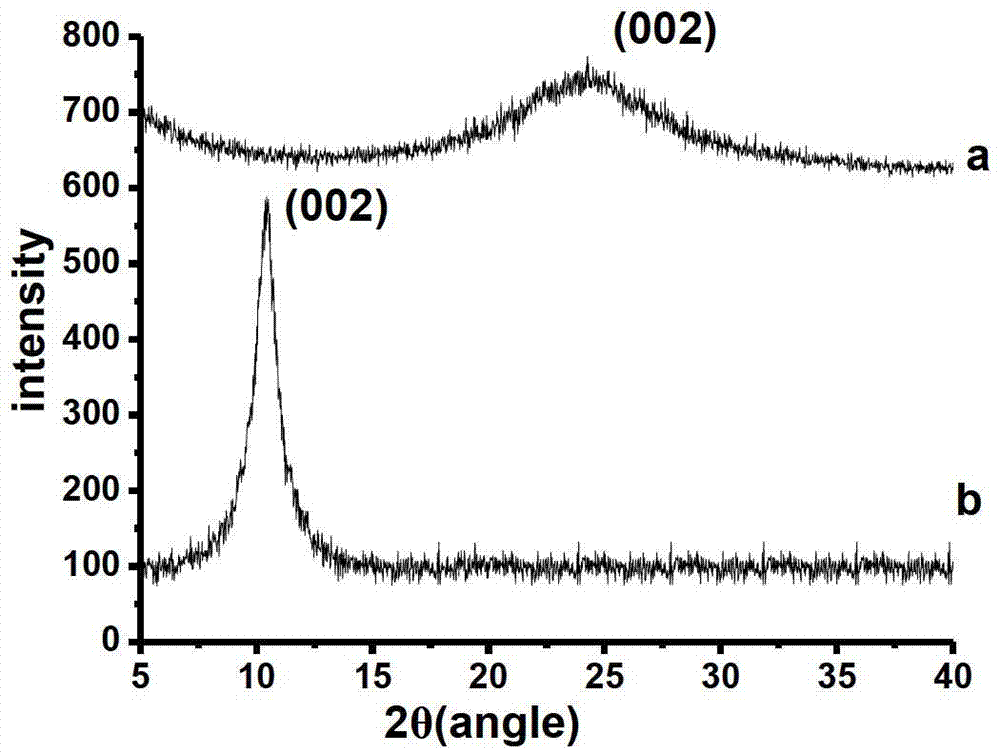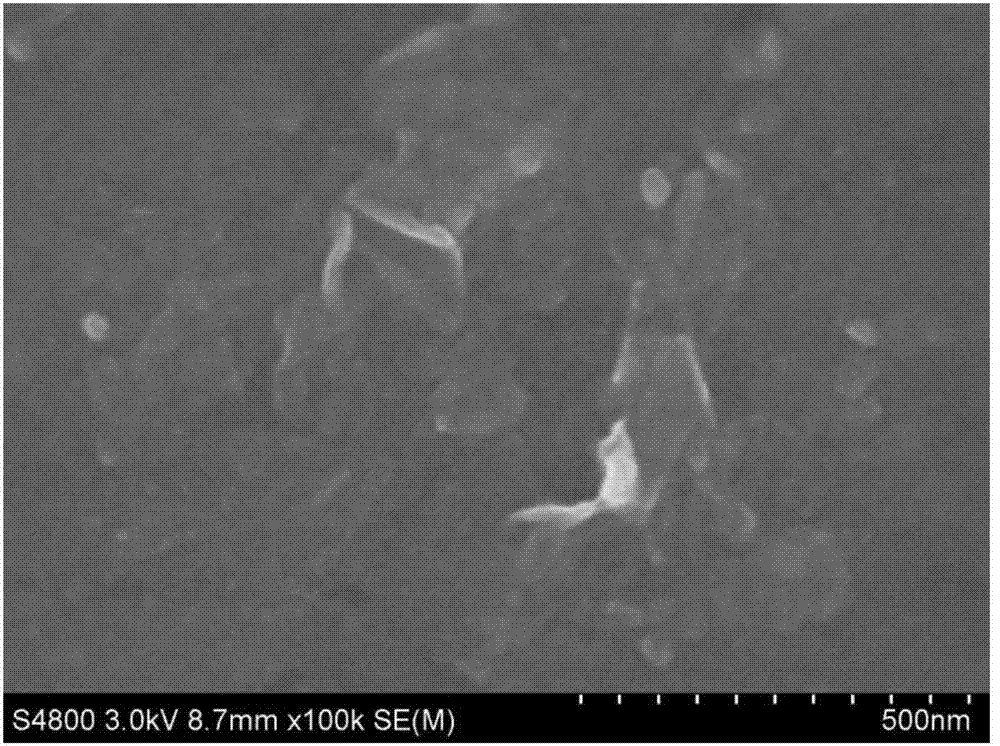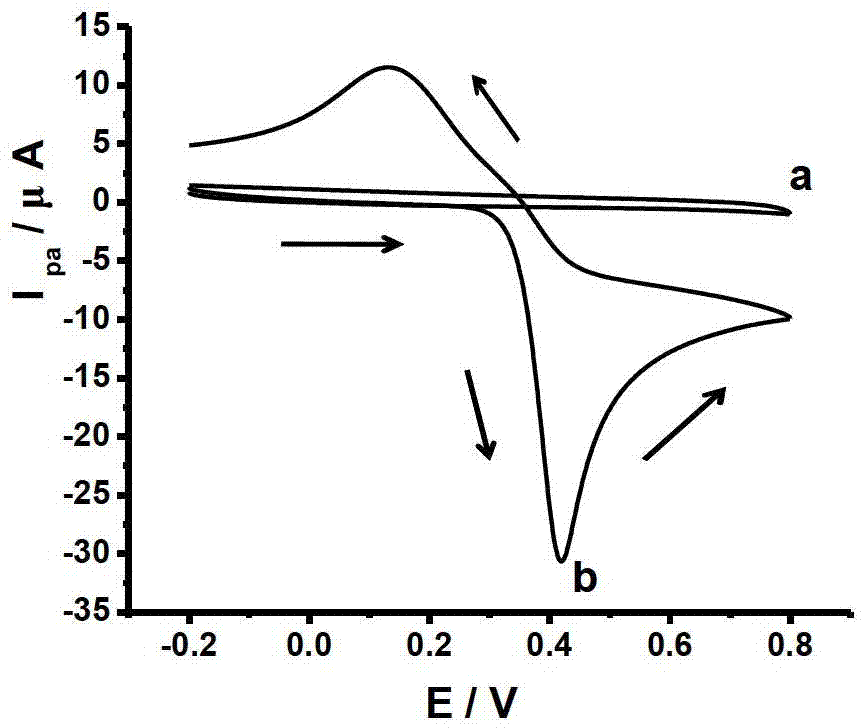Graphene nano material-modified glassy carbon electrode based on phytic acid dispersion, preparation method and application
A glassy carbon electrode and nanomaterial technology, applied in the fields of electrochemistry and nanomaterials, can solve the problems of slow response time and poor reproducibility of detection electrodes, and achieve fast response time, good electrocatalytic oxidation activity, and good reproducibility. Effect
- Summary
- Abstract
- Description
- Claims
- Application Information
AI Technical Summary
Problems solved by technology
Method used
Image
Examples
Embodiment 1
[0028] (1) Grind the glassy carbon electrode with 0.3 μm aluminum powder, then ultrasonically treat it with ultrapure water, absolute ethanol, and ultrapure water for 4 minutes, and dry it at room temperature to obtain a clean glassy carbon electrode, which is ready for use;
[0029] (2) Disperse 1 mg of graphene (synthesized graphite oxide by modified Hummers method, and then reduce graphite oxide by hydrazine hydrate method) in 1 mL of phytic acid solution with a mass concentration of 50%, and ultrasonically treat it for 6 hours to obtain a mass concentration of 1 mg The phytic acid dispersion of graphene / mL;
[0030] (3) Immerse the clean glassy carbon electrode in the phytic acid dispersion of graphene with a mass concentration of 1mg / mL in step (2), self-assemble for 1.5h, take it out, wash it with ultrapure water, and dry it to get A glassy carbon electrode modified by phytic acid-dispersed graphene nanomaterials can be used for the detection of acetaminophen.
Embodiment 2
[0032] (1) Grind the glassy carbon electrode with 0.3 μm aluminum powder, then ultrasonically treat it with ultrapure water, absolute ethanol, and ultrapure water for 5 minutes, and dry it at room temperature to obtain a clean glassy carbon electrode, which is ready for use;
[0033] (2) Disperse 0.1 mg of graphene (the graphite oxide was synthesized by the modified Hummers method, and then reduced by the hydrazine hydrate method) in 1 mL of phytic acid solution with a mass concentration of 50%, and ultrasonically treated for 6 hours to obtain a mass concentration of Phytic acid dispersion of graphene at 0.1 mg / mL;
[0034] (3) Dip the clean glassy carbon electrode in the phytic acid dispersion of graphene with a mass concentration of 0.1 mg / mL in step (2), self-assemble for 2.5 hours, wash it with ultrapure water after taking it out, and dry it in the air. A glassy carbon electrode modified based on phytic acid-dispersed graphene nanomaterials was obtained, which can be used ...
Embodiment 3
[0036] (1) Grind the glassy carbon electrode with 0.3 μm aluminum powder, then ultrasonically treat it with ultrapure water, absolute ethanol, and ultrapure water for 3 minutes, and dry it at room temperature to obtain a clean glassy carbon electrode for use;
[0037] (2) Disperse 4 mg of graphene (synthesized graphite oxide by modified Hummers method, and then reduce graphite oxide by hydrazine hydrate method) in 1 mL of phytic acid solution with a mass concentration of 50%, and ultrasonically treat it for 6 hours to obtain a mass concentration of 4 mg The phytic acid dispersion of graphene / mL;
[0038] (3) Immerse the clean glassy carbon electrode in the phytic acid dispersion of graphene with a mass concentration of 4 mg / mL in step (2), self-assemble for 2.5 hours, take it out, wash it with ultrapure water, and dry it to obtain A glassy carbon electrode modified by phytic acid-dispersed graphene nanomaterials can be used for the detection of acetaminophen.
[0039] Performan...
PUM
 Login to View More
Login to View More Abstract
Description
Claims
Application Information
 Login to View More
Login to View More - R&D
- Intellectual Property
- Life Sciences
- Materials
- Tech Scout
- Unparalleled Data Quality
- Higher Quality Content
- 60% Fewer Hallucinations
Browse by: Latest US Patents, China's latest patents, Technical Efficacy Thesaurus, Application Domain, Technology Topic, Popular Technical Reports.
© 2025 PatSnap. All rights reserved.Legal|Privacy policy|Modern Slavery Act Transparency Statement|Sitemap|About US| Contact US: help@patsnap.com



